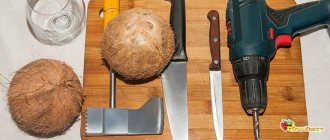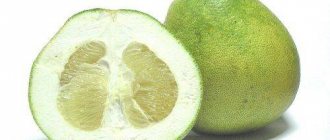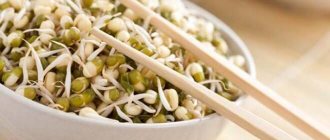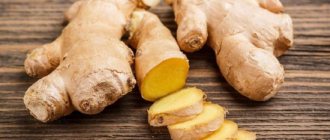Coconut - description and properties
Coconut is commonly called a nut, but this is a misconception. The coconut is a fibrous single-seeded stone weighing up to 2.5 kg. The outside coating is fiber. The inside of the shell is strong, with three seed pores, but only one progresses. The pulp is a thick layer of white color up to 12 mm. Initially, the endosperm is in a liquid and pure form. During the ripening period, yellow drops of oil begin to secrete from the pulp.
Coconut has a unique composition of chemical elements: vitamins, macroelements, microelements, antioxidants, fiber, fatty acids, protein and saccharides. The beneficial properties of coconut have been known since ancient times and are actively used today.
A significant proportion of coconut fruit is grown on commercial farmland. Cleaning is manual or mechanical. The hard shell is incised and divided into several parts. The copra remains in the shape of a sphere. The extracted part is further dried for several months in the sun or by accelerating the process in a special oven.
Most of the pulp consists of water and oil. The remainder consists of fibers and solids. About thirty-five drupes can yield up to five kilograms of pulp. A mature coconut may not have a fibrous covering. Under the firm surface, the thickness of the pulp exceeds 1.5 cm. It has a more compact texture and a pronounced taste.
As the coconut ripens, there is less water. It absorbs more and more oil from the pulp and gradually becomes thick, hardens and dries completely.
Fresh copra is used much less for food. Dried volumes are increased due to the extraction of coconut oil.
What is a coconut
On average, the weight of an exotic nut ranges from 2 to 3 kg, and its length is about 25-30 cm. The largest coconut is called Coco de Mer.
Translated, this means sea nut. The palm tree with this unusual fruit grows only in the Seychelles. The weight of one fruit reaches from 10 to 25 kg. This is the main reason why unusual nut collectors are prohibited from wearing ordinary clothes. They must wear only a special uniform. It can protect a person from the largest falling nut, which can cause serious injury or even kill the picker. The large product contains a large number of various useful and nutritious substances, rals and vitamins.
Palm trees grow very close to water. Therefore, after ripening, nuts often fall there. To preserve all its positive qualities, a hairy fetus must be able to withstand unfavorable conditions. Nature has carefully taken care of this, making sure that each nut is covered with a special protective layer in the form of lignified fibers, and underneath there is a hard shell, which helps preserve everything that is inside the coconut.
Coconut fruits consist of:
- the flesh is white. In a fresh product, its thickness is about 12 mm;
- coconut liquid, which is a mixture of protein and starch. When the fruit is not yet ripe, its juice is clear or slightly cloudy in color. A ripe coconut already contains oils in the water, which makes the endosperm yellowish.
Each of the components of the coconut fruit has its own delicate and pleasant aroma and taste. People have learned to use not only the internal components of the coconut, but also its shell and even the palm tree itself.
Calorie content and nutritional value of the fruit
100 g of the edible part of coconut contains 354 calories. The pulp contains:
- proteins – 3.33 g;
- fats – 33.49 g;
- carbohydrates – 15.23 g;
- dietary fiber – 9 g;
- water – 46.99 g;
- ash – 0.97 g.
The high calorie content of fresh coconut is due to its high fat content. Beneficial properties are determined by the presence of vitamins:
- B1 – 0.066 mg;
- B2 – 0.02 mg;
- B4 – 12.1 mg;
- B5 – 0.3 mg;
- B6 – 0.054 mg;
- B9 – 26 mcg;
- C – 3.3 mg;
- E – 0.24 mg;
- K – 0.2 µg;
- RR - 0.54 mg.
Macroelements and microelements:
- potassium – 356 mg;
- calcium – 14 mg;
- magnesium – 32 mg;
- sodium – 20 mg;
- phosphorus – 113 mg;
- iron – 2.43 mg;
- manganese – 1.5 mg;
- copper – 435 mcg;
- selenium – 10.1 mcg;
- zinc - 1.1 mg.
Also includes:
- digestible carbohydrates;
- essential and non-essential amino acids;
- styrene;
- fatty acid.
The mineral composition of the fruit is close to the required amount for daily consumption.
Coconut: culinary uses
The consumption of coconut fruits has become widespread in Asian countries. Paradise nuts are especially often consumed at the height of the season in Thailand, India, Indonesia and Sri Lanka.
The snow-white pulp of the product is ideal for local cuisine. It’s as if someone specifically decided to grow palm trees in this area. Coconut milk is used to prepare delicate and aromatic desserts that will appeal not only to children, but also to all adults. The liquid can also be added to dishes such as:
- bakery;
- Main dishes;
- sauces;
- soups.
One of the most delicious and famous dishes in which coconut milk is the main ingredient is Thai soup. The simplicity of its preparation is combined with a refined and refined taste.
What are the benefits of coconut for the body?
Health Benefits of Coconut:
- Supports immune system health. Kills pathogenic bacteria, fungi, yeast and viruses through the antimicrobial effects of fatty acids.
- Provides a natural source of quick energy, enhances physical and athletic performance.
- Improves digestion, absorption of nutrients, vitamins and minerals.
- Improves insulin secretion, stabilizes blood glucose levels. Relieves symptoms associated with diabetes.
- Helps protect the body from cancer by removing free radicals that cause premature aging and degenerative diseases.
- Reduces the risk of cardiovascular diseases.
- Restores and supports thyroid function.
- Helps protect against kidney disease and bladder infections.
- Supports weight loss.
- Helps maintain healthy, youthful hair and skin, preventing wrinkles, sagging skin, and age spots.
- Prevents strokes and brain disorders, Alzheimer's and Parkinson's diseases.
- Fights bacteria that cause tooth decay.
Exotic fruits are distinguished by their unique growth, which is uncharacteristic for most people. Many people think about the benefits and harms of coconut for the body.
For men
The main benefit of coconut pulp for men is to increase potency and improve reproductive functions. Many preparations contain elements of coconut fruits. Regular consumption of fresh product helps prevent diseases of the genitourinary system.
The high content of vitamins and protein contributes to the accelerated development of muscle mass. The body's endurance increases.
In addition to the benefits of coconut for the male body, harm is also possible. It is worth adhering to the recommended consumption rate and taking into account individual characteristics.
For women
Coconut can be considered a universal beauty product. The benefits of coconut for women are determined by the high content of acids that help restore and maintain reproductive functions. Prolongs the onset of menopause.
Vitamins and minerals are contained in various cosmetics. Masks and creams for the face and body smooth out wrinkles, moisturize, tone, and have a rejuvenating effect. Strengthen and restore damaged hair structure, preventing hair loss.
The benefits of coconut and the choice of fruits
This is misleading, as these species are simply stages of ripening of exotic fruits. The fresher coconut is the green fruit. It has a softer shell, which hides a transparent liquid inside the coconut.
They are used to make oil and special essence, which combine perfectly with other components of cosmetic products. Together they will be able to achieve maximum results. Everyone can easily prepare cosmetics or other interesting and useful things at home. Particularly popular are:
- soap;
- cream;
- sunscreen;
- various masks.
Important!
The main advantages of coconut cosmetics are its nutritional, moisturizing and protective properties.
The fruits go on sale after the cleaning and drying procedure. Therefore, many people think that the coconut is actually small in size. They are collected in the season after the fruits ripen.
Important!
Green fruits are poorly transported, and brown ones go on sale less fresh, which explains their tart taste.
Before you buy a coconut, you don’t need to pay attention to how much it weighs. It is much more important to carefully examine its shell. It must be intact without various dents, chips, cracks, as well as without signs of rot and mold. After this, the fruit needs to be shaken. A good and ripe nut, harvested at the height of the season, has the sound of splashing coconut water inside.
The more the fruit weighs, the more likely it is to contain a lot of pulp and coconut milk. From one kilogram of an average fruit of paradise, which was grown in favorable conditions, you can get 500 grams of pulp and 300 ml of milk.
Coconut contains a lot of nutrients and vitamins of different groups. It is made from
Opened coconut
confectionery products, added to porridges, whipped oil, useful in cosmetology and the food industry. People drink coconuts and eat their flesh just like that. Coconut juice relieves thirst, saturates the body without giving it additional load from fats and carbohydrates, is well absorbed, cleanses the digestive tract, and has practically no contraindications. The listed points apply only to ripe, fresh fruits.
Scooping out the pulp with a spoon
Here are some tips for choosing coconut palm fruits in a store with no experience at all.
- Take two coconuts of the same size. Choose the one that is heavier. It contains more liquid, which means it is riper and fresher. For information. A ripe coconut contains about half a liter of juice.
- Shake the nut. There should be a liquid gurgling inside, the so-called coconut milk. If this is not the case, then the coconut is dry and should not be purchased.
- The color of the fruit should be uniform, without spots. Any darkening is internal rot.
- There are three dark dots at one end of the fruit. Beat them with any force - if the nut is fresh, you will not be able to damage them with your hands.
- Various mold or rot on the shell indicates internal rotting of the pulp, do not believe the seller’s beliefs to the contrary!
It’s always interesting how this or that fruit is eaten in its homeland. There are a lot of coconuts in Thailand, they are sold everywhere, sometimes they fall right at your feet. Local residents cut a thin green peel along the top along the perimeter, cut it out with a knife and knock out the “bottom”. Now you can insert the solo and drink. Aborigines value juice for its ability to quench thirst and satiate at the same time.
After opening, the coconut must be eaten. There are various conflicting reviews about the taste characteristics of the fruit. Some people like juice, others like copra. There are people who love coconut flakes in ready-made dishes: in candies, butter, cakes. Copra is eaten with a spoon, or, after peeling off the hard crust, it is simply chewed in pieces. You can grate it and add it to prepared foods: porridge, soups, main courses.
The biggest problem after opening a coconut is storage. It is better to eat it fresh, because it is stored only for 2 days in the refrigerator, then it begins to rot. Coconut oil is stored well, since it is already a processed product, milk and juice - less than a day. What to do if it’s impossible to eat everything, but it’s a pity to throw it away?
Several ways will help you prepare coconut correctly:
- Freezing. You can store the pulp in the freezer for up to 8 months without losing the benefits of the coconut. Milk is poured into ice molds and used for cocktails and added to confectionery products. The shelf life of frozen milk is up to 3 months.
- It is good to dry the copra in an electric dryer or in an oven at 60 degrees for 3 hours. It is better to store dried shavings in sealed bags to prevent foreign odors from entering. Milk, confectionery powders are made from it, and added to sauces.
The main thing is not to confuse the juice of the coconut fruit and the finished product. Which was called milk for its characteristic consistency and color. A delicious and healthy product made from coconut copra is sold in stores or made at home.
For this you will need: a glass of coconut flakes made from pulp, water and a blender.
- Pour 4 tbsp of chips into a glass. water and refrigerate overnight. This is necessary to soften copra.
- Take out the next day, beat with a blender until smooth, strain through a sieve. The milk is ready. You can simply drink it or use it to make confectionery.
The indigenous people of the countries where coconut grows value its juice most of all, and copra is processed and preserved, and coconut oil or milk is produced for export. But at home, the nut is eaten whole with great pleasure. Bon appetit!
Contraindications for use
Coconut has virtually no contraindications. Moderate consumption of coconut cannot harm the body. The exception is individual intolerance and allergic reactions.
Harm from coconut occurs when it is oversaturated with vitamin and mineral composition. This high-calorie product is recommended to be used with caution by people suffering from diabetes, overweight and stomach disorders.
You can be poisoned by coconut if you choose the wrong nut and do not comply with storage standards. At the first signs of poisoning, you should seek medical help.
Using the beneficial properties of nuts in modern medicine
A scientific study of the properties of coconut confirmed the effectiveness of its use in the treatment of various diseases. For example, an ability has been identified that weakens the effects of herpes viruses, SARS, influenza and other equally dangerous diseases. Coconut has proven to be effective in the fight against worms, parasites, and Giardia. The combination of beneficial components of the nut has a good effect on the skin and hair.
Coconut also helps in treating stomach ulcers and promotes improved digestion. Preventing the occurrence of heart disease and atherosclerosis, the nut protects the arteries, making their walls stronger. It does not cause discomfort during treatment and has no side effects.
Coconut pulp: features and properties
Coconut pulp can be consumed fresh or dried. The dried oily part is called copra.
Coconut pulp contains vitamins and minerals that have healing properties:
- potassium is involved in conducting nerve impulses and regulating blood pressure;
- phosphorus is involved in almost all physiological processes;
- iron is found in proteins and enzymes;
- manganese promotes the formation of bone and connective tissue;
- copper stimulates the absorption of carbohydrates and proteins;
- Selenium is involved in strengthening the immune system.
Fresh
Fresh coconut product contains fewer calories than dried coconut product - only about 350 kcal per 100 g. The pulp is white, even in color, quite dense, with a soft, pleasant aroma. If copra has an uneven color with dark inclusions, a specific aroma and taste similar to soap, then this indicates deterioration of the product. The taste depends on the variety and place of growth. More common is a sweetish taste with a milky tint.
Fresh coconut meat is not to everyone's taste. When chewed, it splits into many small pieces. A long and tedious process. You can use paste or cubes. The calorie content of coconut cubes is 645 kcal per 100 g of product. Pasta contains slightly less - 630 kcal.
Coconut paste retains its benefits if all production and storage standards are observed, otherwise it may cause harm to health. It is worth considering the manifestation of allergic reactions to the product.
Dried
The energy value of dried coconut fruits is 570 kcal per 100 g of pulp. Dried coconut is a source of essential amino acids and multivitamins, which affects protein synthesis in the body.
The dried pulp is used in the form of flour, shavings, and candied fruits. Regular consumption has a beneficial effect on the restoration and production of new collagen cells. Maintains the tone of connective tissues, preventing sagging skin and the appearance of age-related wrinkles. The vitamins in dry coconut are used as a supplement to substances that stimulate sexual desire.
How to eat coconut
It is customary to eat coconut pulp and its milk. Since the liquid has a short shelf life, it must be drunk immediately. You can wait until the milk begins to thicken and then add it to the pulp. This is called coconut cream and is also used as a dressing for fruit salads.
How to eat coconut after expressing its milk? It’s very simple: cut it into slices. Coconut goes well with tropical fruits, pineapple, citrus fruits, and chocolate. Walnut shavings are used to decorate cakes, ice cream, and cookies.
One coconut can replace a full meal. Milk contains vegetable fats, which give a feeling of fullness. And the pulp is a high-calorie product; it contains ninety percent saturated fat.
There are many recipes that tell you how to properly eat coconut with fish, chicken, and shrimp. At home, it is enough to simply prepare Thai coconut soup, sweets, and pie.
Useful properties and contraindications
Each plant has a different chemical composition. Coconut drupes have both beneficial properties for the body and contraindications:
- exclude from the diet for people suffering from allergic reactions;
- limit consumption to overweight people and during pregnancy;
- take into account the chemical composition when taking balanced vitamin complexes to avoid oversaturation;
- children under three years of age;
- Use with caution in patients with diabetes.
During pregnancy and lactation
Coconut is useful during pregnancy and lactation. Not only consumption is considered, but also external use.
The beneficial substances found in coconut contribute to:
- normalization of water balance;
- intensive tissue hydration, eliminating swelling;
- alleviation of toxicosis, relieving vomiting;
- normalization of digestion, elimination of constipation;
- removal of toxic substances;
- strengthening the immune system;
- increasing the performance of the heart muscle;
- reduction of varicose veins;
- improving the functioning of the liver, kidneys and bladder.
Coconut is included in a healthy diet for a young mother. The rich vitamin composition helps to establish breastfeeding. Increases the nutritional value of milk. Coconut milk replenishes fluid balance in the body. Accelerates the healing processes of cracks and abrasions on the nipples.
In childhood
In the places where it grows, coconut is introduced into the child’s diet quite early. The introduction of an exotic nut is possible no earlier than two years. The body is sensitive to new products. You should start taking small portions and gradually increase them. If there is a possibility of allergic reactions, it is better to start administration at three years of age.
Coconut pulp is useful for valuable microelements and substances involved in the full development of the child. The ratio of proteins, fats and carbohydrates corresponds to the necessary replenishment of the daily requirement for active growth.
It is useful to eat coconut for the proper formation of bone tissue. High calcium content improves dental health. Iron prevents the development of anemia.
The exotic nut is a good source of fluid replenishment. Coconut water has all the essential minerals and vitamins and is very low in calories. This is an alternative to sweet drinks in the summer. Improves digestion and skin condition. When applied topically, it prevents the appearance of blemishes and pimples.
For diabetes
The compliance of BZHU in diabetes mellitus is of decisive importance. Proteins, fats and carbohydrates affect the production of glands and insulin.
For a healthy diet, it is recommended to consume at one meal:
- proteins – 10-15%;
- fats – 30-35%;
- carbohydrates – 50-55%.
The percentage must take into account weight, activity level and age. Snacks should not exceed 15 grams of carbohydrates.
Coconut contains:
- carbohydrates – 25.2%;
- fat – 66.8%;
- proteins – 8%.
Opinions vary on how much coconut meat you can eat per day. Doctors advise consumption in small quantities to improve metabolism. Raw coconut meat contains virtually no simple sugars. Low carbohydrates and dietary characteristics enhance health benefits.
An easy way to open a coconut and scoop out the pulp
The hardest part about eating coconut is peeling it. Before you start cleaning, you should once again carefully inspect the fruit to ensure there are no cracks, chips, or dents on it.
Then three points are found with which the nut is attached to the tree. These points are darker than the fruit itself; they are the softest on the entire surface. To open the nut, select the point closest to the top and pierce it with a knife, screwdriver, etc. Then, using a straw, drain the juice or milk and continue to break the nut. It is most convenient to split the coconut into two parts. To do this, about three points, find a line at the top and, using a hammer, or a chop mallet, or any handy tool convenient for you, split the fruit into two parts. To speed up the cracking process, you can heat the nut in the oven.
If you purchased a ripe and fresh fruit that has ripened naturally on the tree, the pulp is easily separated from the shell. If it fits tightly in the peel and is difficult to separate, it means that the fruit was picked green and ripened in unnatural conditions for it. This pulp is separated with a knife.
Eating coconut copra is a necessary condition for health and longevity. This valuable product is not just tasty and aromatic, but also very healthy for humans. To protect yourself from the mistakes of purchasing a low-quality product, you should carefully select it, paying attention to the appearance of the shell and the sounds when shaking the nut. If you choose the right delicacy, you will be able to fully enjoy the aromatic, delicious, tender nut and its milk.
Application area
Due to its chemical composition, coconut is used in various fields. Application areas are not limited to cosmetology, cooking and treatment. The shell is an excellent basis for making souvenirs, tableware, and musical instruments. Household and building materials are produced from fiber.
Cosmetology
Coconut pulp is used to obtain oil, which is used to produce perfumes and body care products. The peculiarities of consuming herbal composition help replenish the necessary microelements for the health and beauty of the skin.
Systematic use of coconut-based products nourishes hair, moisturizes and protects from external influences. The oil is used in massage treatments. Gently cares for the skin and relaxes the central nervous system.
For medicinal purposes
The tropical nut has found application in folk and traditional medicine. It is part of various drugs that have anti-inflammatory and antifungal effects. Some components have a good effect on the functioning of the body and metabolism, and help normalize digestion.
Cooking
Coconut is widely used in cooking. It is eaten in various forms: fresh, dried, as a paste, chips. High nutritional value energizes, strengthens the immune system, removes waste and toxins.
The shavings are added to baked goods, porridge, salads, and snacks. Drinks, soups, and desserts are prepared using milk. You shouldn’t limit yourself even to those people who adhere to proper nutrition and a special diet.
When losing weight
It is believed that to lose weight you need to include coconut in your diet. Often used as part of a low carbohydrate diet. The right vegetable fats replenish the energy balance necessary for natural activity.
When losing weight, coconut helps reduce appetite, reduce hunger and quickly replenish satiety. Eating on the coconut diet is easier, even if you follow a strict plan.
Features of exotic nut
Before you eat coconut, you need to get to know it better. This is done in order to understand what can be eaten in coconut, and what is better to avoid immediately. An exotic product is a stone fruit. It grows on coconut palms right on the sandy shores of the sea. Paradise nut has been known to people in hot countries for thousands of years. During this time, they found application for it in various fields. They have a large number of different recipes for using coconuts for food, for cosmetic purposes, to relieve thirst and restore energy, and also as a medicine.
Today, 1/3 of the planet’s population is engaged in growing and collecting paradise nuts in different conditions, as well as producing products from them, which indicates the importance of this product. They also introduced unique traditions on how to eat coconut and which parts of it are best to use at home in the future.
There are different types of exotic nuts, but on average each fruit weighs from two to three kilograms. Inside contains coconut milk or water, as well as pulp. Each of these components can be used in different ways.
It is very popular to use coconut bark for household purposes. It is called coir and is the hard inner shell of the fruit. Initially, residents of warm countries used it to produce furniture and make mattresses. Today it is in demand in almost all countries of the world.
Coconut pulp and juice are used as food for preparing various dishes, desserts, drinks, as well as for the production of cosmetics.
Choose a delicious coconut when purchasing
Coconut palms are characteristic of southern latitudes. Not every person knows how to choose a good coconut:
- Specify the delivery date of the last batch. Many stores do not receive goods regularly. It is important to note that coconut is harvested at an early stage of maturity for export.
- Shake the coconut and pay attention to the characteristic sounds of the liquid inside. A sufficient amount of coconut water is a good indicator of the freshness and ripeness of the nut. If the water sounds are weak, there are likely cracks and leaks. In areas of leakage, mold may develop and enter the fruit.
- Examine the three ovules - dark dots on one side of the coconut. Only one of them has a thinner surface and is capable of germinating. The eyes are checked for damage.
- Search for cracks, mold and damp areas. Coconut does not show any cracks due to its fibrous surface. But you can notice the formation of even the smallest crack with small damp or moldy areas.
- You need to choose a heavier coconut. When comparing several options of the same size, you should choose the fruit that weighs more.
Fresh coconut has a uniform flesh color and a pleasant, delicate smell. It is easy to open by correctly determining the location of the soft eye. It looks different from others: the dark part is larger. Carefully make a hole with a thin knife, pressing and turning slowly. To fully open, you will need a wide knife. Tap with the flat side in a circle until you hear a characteristic crack. Knock on the axle until a crack appears. Open with your hands using a little force.
If you follow the basic rules for choosing a good coconut, you have a chance to purchase a tasty fruit. Before opening, it is almost impossible to determine the taste.
How to choose a coconut
For those who are not very experienced in choosing coconuts, it will be useful to learn how to choose the right one.
Coconut fruits arrive in our stores already peeled from the skin and fibrous shell and weigh on average from 500 to 1000 grams. From one such fruit you can get up to 300 ml of coconut milk and up to 500 grams of juicy pulp. 1. Before purchasing, carefully inspect the coconut from all sides. It must be intact, without cracks, without traces of rot and mold. Take two fruits that are approximately the same size and choose the one that is heavier. This coconut will have more pulp and milk.
2. When choosing, don’t be afraid to shake and knock on the shell. When shaking, milk should splash inside the coconut, but if you hear a dull sound when tapping, then you should not buy such a coconut, since the core is most likely dry. If you notice traces of mold on the hair shell, it means that the coconut has begun to deteriorate inside and you shouldn’t take it either.
Rules for storing open fruit
A whole coconut will keep for a month in a cool, dark place. Fruits with open shells can be stored in the refrigerator for up to three weeks. When frozen, the elastic pulp can be stored for up to two months. After time has passed, the product may begin to ferment. For long-term storage, the pulp is crushed to the state of chips and dried. Keeps for twelve months in a tightly closed container, like many spices.
Coconut milk is stored after preliminary cleaning of shell pieces. After extraction, it is advisable to consume immediately.
If this is not possible, then place in a sterile, tightly closed container.
Coconut pulp can be stored for no more than seven days. Fill with cool, purified water and place in the refrigerator. Freezing may result in loss of quality. The structure becomes loose and some of the nutrients are lost.
Storage
Eat the nut immediately after opening; it does not last long. The endosperm deteriorates especially quickly.
How to store the pulp: wrap it in film and put it in the refrigerator. There she can lie for up to one month.
The monkey-shaped coconut is worth the trouble of opening it. Imagine how diverse your menu will be and what benefits your body will receive.
I hope that my instructions on how to open a coconut will help you. And I will continue to tell you about various healthy nuts.
Top 5 best recipes with coconut pulp
You can prepare an endless variety of dishes, drinks and desserts at home from coconut pulp.
The most popular recipes.
Coconut balls:
- shavings – 150 g;
- egg – 1 pc.;
- sugar – 3 tablespoons;
- banana – 1 pc.;
- hazelnuts – 6 pieces.
Break an egg into a bowl, add sugar and beat thoroughly. Grind the banana, add shavings. Mix everything into the mixture. When making a ball, place hazelnuts in the middle. Place on a baking sheet. Bake at 180 degrees for 15 minutes.
Nutritious breakfast:
- oatmeal – 2 cups;
- almonds – 60 g;
- raisins – 60 g;
- dried apricots – 100 g;
- walnut – 50 g;
- honey – 50 g;
- brown sugar - 2 tablespoons;
- butter – 60 g;
- coconut flakes - 2 tablespoons;
- water – ¼ cup.
Rub or crush the nuts. Mix in a bowl with coconut and dried apricots. Bring the syrup of water, sugar and honey to a boil. Pour the liquid into a bowl. Cover with foil and place in the oven preheated to 200 degrees. Bring to readiness for 10 minutes.
Vitamin cocktail:
- coconut water – ½ cup;
- mineral water – ¼ cup;
- fresh pulp – 80 g;
- honey - teaspoon;
- orange.
Grind the pulp on a grater. Add honey, orange juice, coconut water. Shake thoroughly. Pour in mineral water.
Coconut chips:
- powdered sugar;
- coconut.
Crack the drupe, drain the water and remove the shell. Cut into thin slices using a vegetable peeler. Place on a baking sheet and place in an oven preheated to 200 degrees for 60 minutes. Sprinkle the finished chips with powdered sugar.
Shrimp in coconut:
- flour – 120 g;
- shrimp – 500 g;
- coconut flakes – 100 g;
- egg;
- spicy sauce;
- black pepper;
- salt;
- vegetable oil.
Peel and rinse the shrimp. Salt and pepper. Prepare three bowls with flour, beaten egg and coconut. Dip the shrimp in the egg, then in the flour and sprinkle with coconut. Fry in oil until golden brown. Serve with hot or sour sauce.
How to peel a coconut
Drain the water
To avoid splashing the entire kitchen, remove the coconut juice first. To do this, find the softest peephole. It is usually a little larger and rounder than the others. Pierce this peephole with a thin, strong knife, screwdriver, awl or thick nail. If the shell is too hard, help yourself with a hammer.
Footage: American Express / YouTube
Now you can insert a straw into the hole and just drink the coconut water. It quenches thirst well and contains Hypoglycemic and antioxidant potential of coconut water in experimental diabetes antioxidants.
The water can be drained by inverting the nut over a bowl, strained and used to make smoothies, cocktails and other drinks.
Open a coconut
Now crack the shell in any way convenient for you. You can carefully cut it with a hacksaw and then use it for crafts. For example, you can pour wax into empty shells and make candles.
If you don't need this part of the coconut, simply put the nut in a thick bag and hit it hard against a wall or other hard surface.
Footage: for Precious Life / YouTube
In one of the articles, Lifehacker collected four more simple ways to open a coconut.
Separate the pulp
If the coconut is not too hard, simply run a spoon, table knife or screwdriver between the flesh and the shell. Try to push the tool as deep as possible to separate the pulp in one large piece.
Photos: Tasty Food by Mitu / YouTube
For harder fruits, it is more convenient to carefully cut off small pieces with a sharp knife.
Place stubborn coconut in an oven preheated to 180°C for 10 minutes or boil for 5 minutes in boiling water. Due to the temperature difference, the inside will become softer and will come off much easier. You will get the same effect by leaving an open coconut in the freezer overnight and then thawing it.
If desired, remove the thin brown skin from the flesh using a vegetable peeler or knife.
What do coconuts look like and where do they grow?
Coconut is a round, slightly elongated fruit of the coconut palm. Its length reaches 25 - 30 cm, and its weight is 2.5 kg. People tend to think of coconut as a nut, which is considered a mistake. This is a drupe, the inner part of which is called the endocarp, and the outer part is called the exocarp. The pulp located inside is 12 mm thick and contains liquid containing nutrients, starch and proteins. This water is called edosperm. As soon as the exotic begins to ripen, it is transparent and a little cloudy. In ripe fruit, the water acquires a yellowish tint and is saturated with oils. Mixing with the pulp, the water turns into coconut milk, which has a sweetish taste.
The best soil for coconut palm growth is sandy soil. The wild variety prefers the tropics. Palm trees grow in large numbers along the coastal strip of the Malay Peninsula, Sri Lanka. The habitats of these trees include the Indian coasts and the Philippines. And in Indonesia, the processing and production of coconuts is the most developed, in which it ranks first.
How to properly break a coconut?
How to split or break a coconut - instructions with photos:
- Place the coconut on a hard surface and turn it towards you with three dark circles that are at the top of the fruit. ...
- We remove the tool from the resulting hole and direct it to the next spot. ...
- If all three holes are ready, it's time to drain the coconut milk.
Interesting materials:
How to reset MI True Wireless Earbuds? How is the depreciation of a car per kilometer driven? How is life expectancy calculated? How is sick leave calculated in 2022? How is salary calculated? How are maternity pay calculated in 2022? How to count two weeks of work upon dismissal? How to calculate continuous work experience according to a work book? How to calculate retirement age? How to calculate a 20 percent discount?
Coconut is a heavenly gift...
Coconuts were discovered a long time ago and it is not known exactly where their homeland is. Malaysia and New Guinea are competing for this title. However, they grow in many warm countries, because by nature they have a persistent distribution.
Popular articles now
The star of the series “Witch Doctor” and “Glukhar” Alexander Samoilov died
What life was like in occupied Lviv in 1943: unique footage of a German soldier
An experienced chef showed how to peel herring from the bones in one motion
A young Ukrainian died tragically at a construction site in Poland, his pregnant wife is crying at home: “For what?”
show more
Scientists say that the reason coconut fruits have such a hard shell (which makes them difficult to open) is so that the seeds inside them can float across the waters undamaged, reaching fertile lands. Thus, it is assumed that coconuts made their way across the seas and oceans for thousands of thousands of kilometers and spread to different islands and shores.
For residents of various hot countries, coconuts are a real gift from heaven. Here coconut palms are considered the tree of life. Its fruits are cut into many ingredients and used not only as food, but also as medicine and a source of profit, exported to countries like ours where coke palms cannot grow due to natural reasons.
How should you eat coconut?
To start eating a coconut, you first need to open it. There are many ways to do this.
You can break a coconut by hitting it hard with a hammer (or just something heavy). But do not forget that coconuts are very bouncy, so it is better to fix it before breaking it.
You can try sawing the hard fruit with a hacksaw.
But these and similar methods have a significant drawback - juice pours out of the nut, which is no less tasty than the pulp.
Therefore, if you want not only to eat coconut pulp, but also to taste coconut milk, it is right to do differently.
- At one end of the nut there are three holes (eyes), which you can try to pick out with a knife or pierce with a knitting needle. If you want to drink juice directly from a hard fruit, you can make two holes and insert a cocktail straw into one of them. In order to simply pour the juice out of the nut, one hole is enough.
- When all the pleasant nectar has flowed out, you can break the coconut and start eating it. The easiest way to open a stubborn nut is to crack it with a large kitchen knife.
- The coconut skin has one weak point, it is located about one-third of the distance from the eyes to the other end. The hard fruit must be placed on a flat surface, find this place and hit it with the blunt side of the knife. Then turn the nut a little and hit again.
- After a few blows, a crack usually appears in the peel, into which it is enough to insert a knife and split it.
So, we are done with opening the coconut, but before you start eating it, you need to carefully inspect the contents. The coconut flesh should be soft and elastic, white, without spots and easily separated from the shell layer. If the pulp does not separate well, it means that the fruit was picked green - however, it can, of course, be eaten.
There are different types of coconuts
I just want to continue: black, white, red. And it will be almost right! In addition to the familiar black coconuts that can be found on the shelves of any large supermarket, there are also green coconuts that grow in India, Sri Lanka, Vietnam, Malaysia and Thailand. We all know the taste of classic brown coconuts from childhood, there is no point in talking about it. Things are different with our green brothers. If the black coconut we love has thick white flesh and sweet clear milk inside, then, for example, a green coconut contains a lot of liquid and little pulp inside. This healthy, heavy nut is primarily for drinking.
In Sri Lanka, Goa and Thailand, such coconuts cost one dollar, right in front of you, resourceful locals will climb a palm tree, cut it with a strong and precise blow of a large knife, insert a tube, decorate it with a living flower, and offer to taste the “heavenly pleasure " But I didn’t like the green coconut pulp at all - it was too slimy and cloying. In general, not for everyone. But the liquid inside is cool and moderately sweet - refreshing on a hot day. It is worth adding that this type of nut is not stored for a long time and quickly disappears, so buying it in the CIS countries is quite problematic. This is why the green young coconut so surprises our tourists in the countries where it grows.
How and where to store an open coconut
The product of the tropics is not subject to long-term storage. A whole nut can be kept for no more than a month without losing its beneficial properties. The storage of an open coconut is 2-3 days, then it begins to ferment.
Milk should be used immediately after opening. You can store it for only a week by sealing the container with it.
The shelf life of the pulp is 7 days. In this case, it should be filled with water. Dried coconut flakes can be stored for the longest time. It can be kept for about a year by placing it in a cool, dry place, tightly closed.
At what age can children eat coconut?
The benefits of fresh coconut are also significant for children. The beneficial calcium it contains plays an important role in the development of the child's teeth and bones. The tropical nut promotes the normal growth and development of the baby, saturates it with energy and nutrients. Drupe oil is a mild, natural remedy that can be used to care for delicate baby skin. But when introducing the product into a child’s diet, it should be taken into account that the child’s stomach is very susceptible. Therefore, it is necessary to give exotic to children from 1.5 to 2 years old. If a child has an allergic reaction to any food, it is better to delay or minimize the consumption of the fruit. It is recommended to introduce exotic fruits into children’s diets from the age of 3, after checking for the absence of allergic reactions.
Features of eating coconut for diabetes and gastritis
Diabetics should consume coconut with caution. You can introduce pulp into your diet in small quantities. The benefit of coconut for the body is also that the manganese it contains reduces blood sugar. For diabetes, you can use exotic water, which tends to relieve fever. But you should avoid sugar, butter and drupe milk. These parts of the tropical fruit are incompatible with diabetes.
For stomach diseases, including gastritis and ulcers, it is recommended to consume milk and dairy products. For people who are intolerant to this type of food, coconut milk is an excellent replacement option. It contains coarse fibers that have a positive effect on the digestive system and improve metabolic processes. Another useful property of tropical milk is its ability to normalize the intestinal microflora without harm to the gastrointestinal tract.
The exotic fruit has antibacterial properties, so it is recommended for use by anyone who has gastritis. But for ulcers, it is necessary to administer a moderate amount of the product so as not to overload the stomach.











